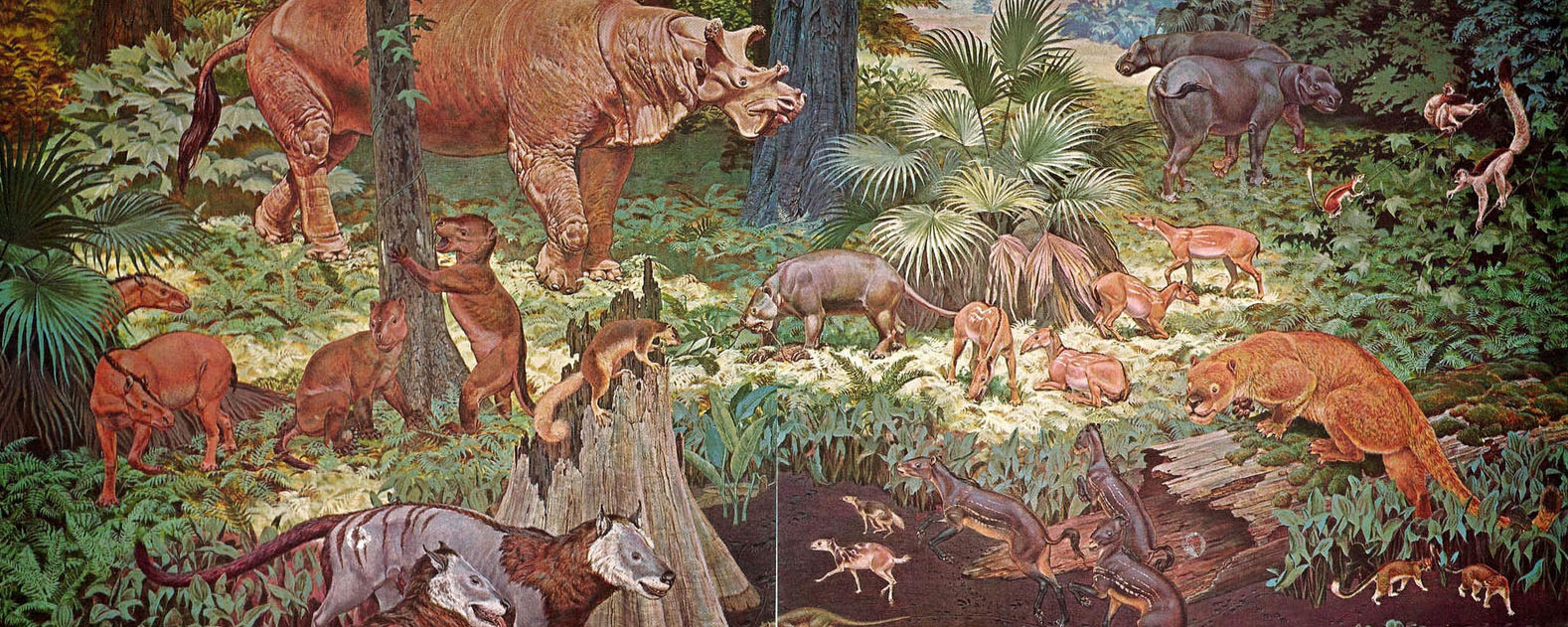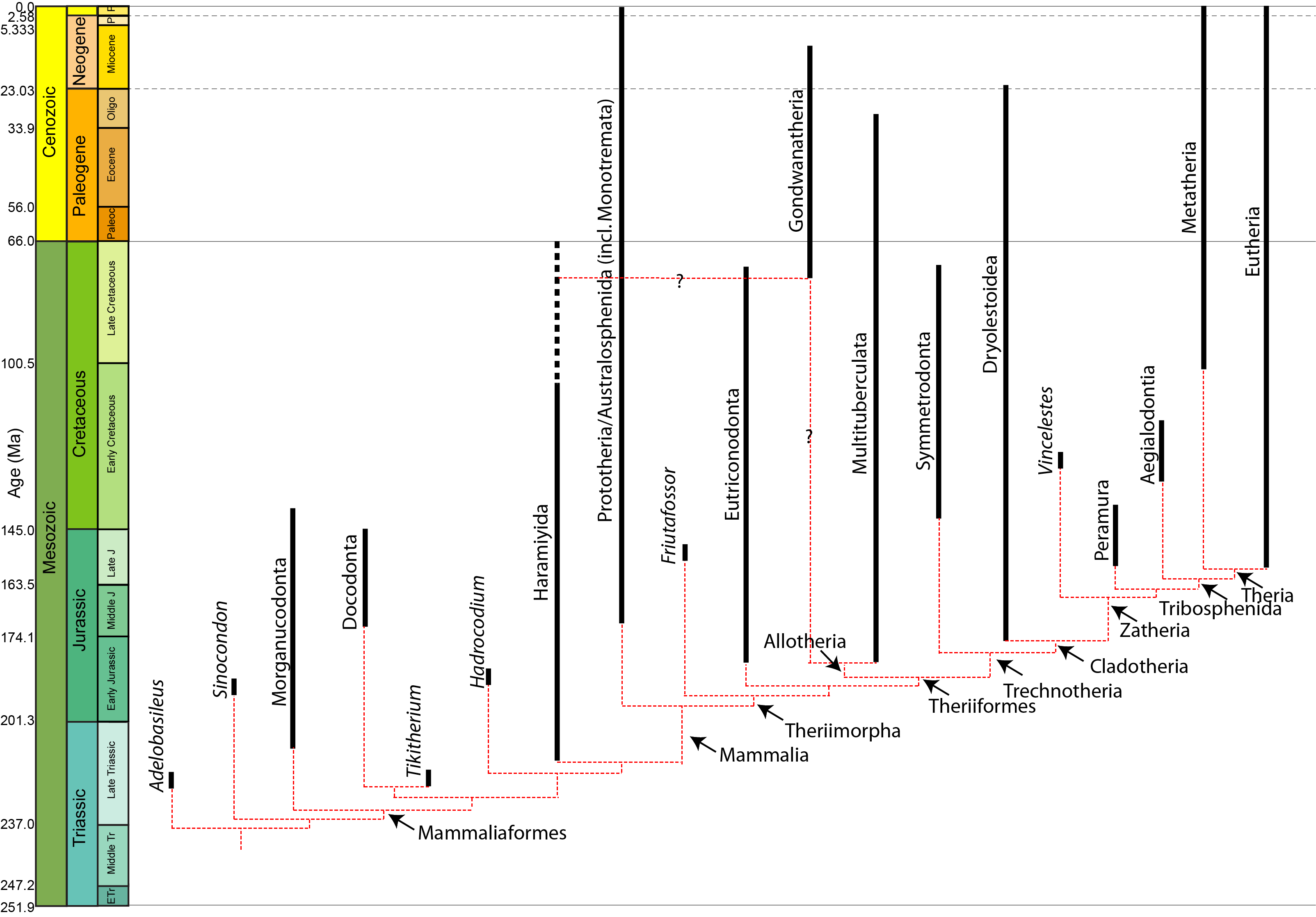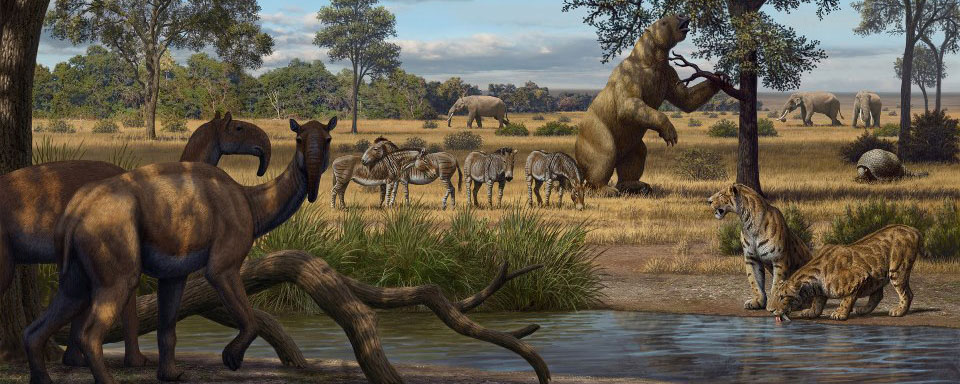


"Milk: it does a body good" -- American Dairy Farmers ad campaign, 1985
BIG QUESTION: Where did mammals come from, and why were they so successful?
The Fur Beasts
Mammalia is not a traditional group that cultures around the world recognized, the way that "birds" or "bugs" or "plants" are. The concept of "mammal" is the product of scientific discovery: in particular, of Linnaeus. This is why we use his formal technical term--literally, the "ones with mammary glands"--rather than some ancient Anglo-Saxon or Latin name for the taxon. The same holds true in other languages: in German they are der Säugtiere, the "animals that suckle", for instance.
While there are fewer mammal species than there are of modern birds or of modern lepidosaurs (snakes, other lizards, and tuataras), mammals are recognized as being ecologically dominant over their other amniote kin in the terrestrial realm. Flying mammals (bats) are a significant part of the flying fauna, and marine mammals (and most especially cetaceans (whales, including dolphins and porpoises)) are a significant part of the larger marine animal community.
There are approximately 5672 living species of mammals. Most of these are rodents and bats: the remainder makes up 2195 species. Mammals include the largest animal of all time (the 30 m long, 173 ton Balaenoptera musculus, or blue whale), as well as many very tiny forms. They inhabit every continent (although only on the shores of Antarctica) and every ocean.
Mammals are easily recognized by numerous synapomorphies:
Living mammals are divided into three clades:
Marsupialia and Placentalia are united as a clade called Theria (the "beasts"). Therians share the following synapomorphies:
Mammals are part of the amniote radiation that arose in the Carboniferous. Specifically, a clade Synapsida represents mammals and all taxa closer to mammals than to lizards and crocodiles (the taxa closer to lizards and crocs than to mammals form the clade Sauropsida). Sauropsids and synapsids (as sister taxa) arose at the same time, but it was the Synapsida that underwent an adaptive radiation first.
Synapsids are characterized by an an expanded jaw opening in the side of the skull, among other traits. Primitive synapsids (sometimes referred to by the paraphyletic term "pelycosaurs") were fairly diverse in the Early and Middle Permian. Among the diversity included:
"Pelycosaur"-grade synapsids retained many basal amniote traits. Bone histology and predator-prey ratios strongly suggest these animals were still cold-blooded. At least some of these had a scaly body covering like sauropsids. While sprawling may be their normal mode of locomotion, tracks show they occasionally achieved a semi-sprawling "high walk" like today's crocodilians.
However, there are other ways in which they were precursors of more typical "mammalian" traits. There is evidence of parental care in the form of multiple half-grown individuals found in the same burrow as a fully-grown Microvaranops.
"Pelycosaurs" evolved themselves out of existence: they were displaced by their more derived descendants the Therapsida. Traditionally called "mammal-like reptiles", but they are not "reptiles" (sauropsids) and we mammals simply inherited therapsid traits. Therapsids have differentiated teeth: nipping incisors, biting canines, and grinding cheek teeth (not yet split between premolars and molars.) They typically had forelimbs more powerfully built than their hindlimbs. Therapsid diversity in the Middle and Late Permian include:
Therapsid posture was typically semi-sprawling.
Where Permian therapsids furry? This remains unresolved. There is skin impressions of one specimen that supposedly shows large scales, but these fossils are not published and is apparently from an environment that wouldn't record fur anyway. There is a coprolite from the Late Permian that has what are interpreted as hair filaments preserved in it, but these might conceivably by plant fragments or fungal hyphae.
Therapsids were the dominant terrestrial amniotes of the Late Permian, and thus suffered strongly in the Permo-Triassic mass extinction. Most clades within Therapsida were wiped out. Two major groups did survive and flourished in the Triassic: the two-tusked beaked Dicynodontia (culminating in rhino-sized latest Triassic Lisowicia) and the carnivorous, omnivorous, and herbivorous Cynodontia. It is among the cynodonts that the mammals arose.
It appears that vibrissae ("whiskers") and the rhinarium ("wet nose") that gives mammals their distinctive appearance was a very late trait in therapsid history. Although these don't typically fossilize, the reorganization of the passages for nasal nerves and blood vessels associated with the these features can be traced in therapsid history. It appears that whiskers and the rhinarium are only present in the closest relations to mammaliaforms among the earlier therapsids. (Intriguingly, a single gene MSX2 controls a number of mammalian traits: maintenance of whiskers and other hair, an enlarged cerebellum, the closure of the skull roof, and the presence of mammary glands! It may be that mutations of this gene represent a rapid transformation in "mammalifying" therapsids.)
Other cases of "mammalification" are more gradual. The shift from a multibone lower jaw to a single bone one, and with it the incorporation of the middle ear is well-documented in step-by-step changes throughout Therapsida. (In fact, new discoveries show that it evolved convergently between monotremes and therians, with some stem-monotremes and stem-therians still retaining a bony connection between the lower jaw and the middle ear bones.
On the other hand, there were still some distinctly non-mammalian traits among the non-mammaliaform therapsids. A recent discovery of the Early Jurassic tritylodont Kayentatherium shows that it had a clutch of at least 38 tiny babies rather than a more mammalian condition of smaller litter size.
Where do mammals start being mammals? Is it when deciduous teeth and a single lower jaw bone appear? Or with the crown-group? Paleomammalogists disagreed about this for generations. However, the current arrangement is to leave Mammalia as the crown group: the concestor of Monotremata, Marsupialia, and Placentalia, and all of its descendants. The more inclusive clade Mammaliaformes (defined as the concestor of Mammalia and Morganucodonta and all of its descendants) conforms closely to the traditional, broader definition of "Mammalia".
The oldest mammaliaforms show up in the Late Triassic, not too long after the oldest dinosaurs and pterosaurs. The oldest crown-mammals show up in the Early Jurassic. Under either concept, mammals spent more of their history in the shadow of the dinosaurs than as the dominant group of terrestrial amniotes.
Mammaliaformes were quite diverse throughout the Mesozoic:

While fur isn't yet confirmed in moganucodonts, their tiny body size suggests it was necessary (especially if they were endothermic). Fur is definitely present in the clades Docodonta and Haramiyida.
Mesozoic mammals may have been "children of the night". The phylogenetic distribution of behavior, of specialized eye pigments, and of pupil shape strongly suggest that the concestor of all mammals (and of all mammaliaforms) was nocturnal. (Cathemerality--activity during both day and night--evolves later and dominates for larger-bodied mammals, and diurnality--activity limited to daytime--being rare, and most common in primates.)
Most Mesozoic mammals very small (shrew-to-house cat sized, with a few badger-sized forms in the Cretaceous); mammals only become large AFTER extinction of non-avian dinosaurs.
Oldest mammaliforms of the Late Triassic and Early Jurassic were fairly small. But by Middle and Late Jurassic, there were already some specialized mammals:
A curious discovery in Mesozoic mammals is that many groups have an ankle spur homologous to that in modern monotremes. It isn't certain if they were poisonous and/or if they were limited to males. So even in this "monotreme" trait is not a synapomorphy of this clade, but rather a retention of a symplesiomorphy which is lost in the derived Theria.
We tend to think of Mesozoic mammals as being at the mercy of dinosaurs, but in at least one case the mammals had the upper hand. The badger-sized eutriconodont Repenomamus contains in its gut the remains of several baby dinosaurs.
Among the various clades of mammals in the Mesozoic are early monotremes and stem-members of the two therian groups. Metatheria is the total-group for Marsupialia, and is known from the Early Cretaceous onward. Eutheria, the total-group for Placentalia, goes all the way back to the earliest Late Jurassic. (Of course, as its sister taxon, Metatheria has to extend as far back in time as Eutheria, but we haven't found or identified the Jurassic metatherians yet.) While Marsupialia proper isn't known until the earliest Cenozoic, fossils of crown Placentalia are known before the K/Pg extinction (and based on genetic divergence many of the branches may have been present much earlier in the Cretaceous).
Several Mesozoic mammals group die out at or before the K/Pg extinction. That said, it wasn't just monotremes, marsupials, and placentals that survived. There are some groups that did well in the early Cenozoic and have since died out.
The small body size and burrowing habit probably favored mammalian survival relative to dinosaurs and pterosaurs, for instance. Mammal species diversity and body size both increase very quickly after the dust settled and the Cenozoic began. Indeed, the placental mammal diversification of the Paleocene Epoch is the original case study of the concept of "adaptive radiation."
The global environment of the early Cenozoic (Paleocene and Eocene Epochs) was warmer and wetter than the modern world, not terribly dissimilar to the previous Cretaceous. Rain forests were common in many regions--even in the mountains of the American West. In the mid-Eocene it was warm enough that the Arctic Ocean in summer was covered by floating Azolla ferns. (In fact, over the space of 800,000 years the annual sinking and sequestering of these seasonal blooms in Arctic Ocean sediments drew atmospheric CO2 levels down from 3500 ppm to 650 ppm.)
The continents of the dawn of the Cenozoic were more separated than at present. As a consequence different continents were biologically isolated. As today, Australasia was an "island continent" (although connected to Antarctica, at least in the beginning), but South America, Africa, Madagascar, and India also lacked direct contact to other landmasses.
A consequence of this was that in the early Cenozoic there was a high rate of endemism (taxa unique to just one landmass). As today, Australasia was dominated by marsupials. Different groups of marsupials and non-marsupial metatheres (which were the dominant predators), as well as specialized endemic placentals. (Curiously, although marsupials are a Southern Hemisphere clade, Metatheria in the Cretaceous is only found in the Northern Hemisphere!)
The remaining regions were all dominated by various types of placentals. North America, Europe, and Asia had some limited connection, so many of the same clades were found in all three. Africa, India, and Madagascar were isolated; later in the Cenozoic the first two collide with Eurasia and there is an exchange of mammals and other animals.
As mammals evolved into apex predators, they required a new specialization: carnassials (shearing premolars and/or molars). This allowed them the slice of large chunks of meat, which ancestral teeth of mammals were not able to do. Carnassials evolved independently in the Sparassodonta (a South American clade of predatory stem-marsupials), in predatory crown-marsupials of Australasia, in "creodonts" (a paraphyletic assemblage of mid-Cenozoic carnivorous placentals in America, Eurasia, and Africa), and in Carnivora (the main clade of placental carnivorous mammals).
To give an example of the diversifications during the Paleocene and Eocene:
With isolation on different landmasses, convergences between different groups are rampant among Cenozoic mammals. Different clades evolve similar body forms due to similar life habits.
In the end of the Eocene the world began to dry and become colder. This transition is extremely quick (taking less than 100,000 years). The primary driver for this is the break up of Antarctica from Australia, forming a circumpolar current and the generation very cold bottom water. This cold bottom water (the Antarctic Bottom Water) is a major CO2 sink, sucking much of the carbon dioxide out of the atmosphere. This cooling of the world resulted in the first Antarctic glaciers.
This event resulted in some extinction events of marine plankton and a major turnover of mammals. In Europe this is called the Grande Coupure ("Big Break") and in Asia and the "Mongolian Remodelling". Throughout the world many early Cenozoic groups die out.
A group that begins to thrive at this time is the grasses. The Oligocene Epoch (33.9-23.03 Ma) saw the rise of grasslands, at least in the form of desert grasslands (primarily taking over from both desert scrub and dry woodlands.) During the Miocene (23.02-5.333 Ma) short grasslands with deep soils really start to take over, and in the late Miocene and Pliocene (5.333-2.588 Ma) we see the spread of tall grasslands with exceedingly deep soils.
Grasslands are one of the most important modern biomes. There are many types and names for these: savannas and veldts of Africa, prairies of North America, pampas of South America, steppes of Eurasia, rangelands in general, etc. (Generally, savanna is used for grasslands with scattered trees, and some other terms for those few or no shrubs and trees.) (Incidentally, woodlands are generally biomes where there is >40% woody plant cover, typically smaller trees where the crowns of the trees do not overlap; while forests are biomes here there is >>40% wood plant cover, where the trees can be more than 20 m tall, and where the crowns of the trees do overlap (and thus small ground cover plants receive very little sunlight.))
Approximately 40% of the modern land surface is covered by some form of grassland. Grasslands typically have very deep soil (in large part because of the rapid turnover of plants). Grasslands are typically associated with dry but not desert conditions: only 500-900 mm/yr rain.
Most of the grassland plants (both grasses and herbs) are annuals (live for just one year), so there is very rapid turnover of plants and thus VERY high productivity. In contrast, forests are dominated by trees which are decades-to-centuries old, and thus nutrients are sequestered in the plant biomass. In addition, although a given unit area of forest might have much more volume of plant matter, the great bulk of that is in the form of woody tissue which is not directly edible to typical vertebrates; in contrast, a very high percentage of a given grass plant is edible. As a consequence of rapid turnover and high percentage of accessible food, grasslands can support vast large vertebrate biomasses.
Fires are very, VERY common in grasslands. In fact, fires promote the maintenance and spread of grasslands, because grass can recover easily from fires, but trees and shrubs typically will need to recolonize in order to be present.
The changing of the environment resulted in major changes in the mammalian communities. To vertebrate zoologists, "grazer" specifies a grass-eater. (That is in fact the etymology of the word!) (Note however that marine biologists use "grazer" for almost any animal that bites off small immobile food, such as algae, polyps, bryozoans, etc.) "Grazers" is contrasted with "browsers" (animals that eat mostly herbs or the leaves of shrubs and trees), with "mixed feeders" as having both grass and browse in their diet.
It had long been observed that the Cenozoic saw a drying of the planet, and a shift from a forest-dominated to a grass-dominated world. Certain adaptations in mammal lineages (such as the evolution of equids (horses), bovids (antelopes, including buffalo, bison, cows, goats, sheep), and the like) were thought to document evolutionary responses to this environmental shift. Grazers are distinct from browsers in a number of aspects of the jaws and teeth:
There are other proxies for grazing vs. browsing. For example, if you look at the surface of teeth under the microscope, browsers typically have fewer scratches and more pits, while grazers have more scratches than pitting. Also the isotopic signal of C4 grasses (about which more below) show up in the chemical composition of the bones and teeth of grazers.
Some other changes from the ancestral forested home to life of the grasslands are tendencies but are not absolute distinctions: you can find some forest dwellers with these adaptations, too:
Many types of mammal (and other animals, to be fair!) diversified in the grasslands, but some of the greatest successes were among the ungulates: in particular, the Artiodactyla (the even-toed ungulates) and the Perissodactyla (the odd-toed ungulates). Indeed, within these two groups, there was huge diversifications in the Bovidae and the Equidae (respectively), both of whom were ancestrally forest-dwelling clades. The evolution of the equids in particular are an excellent example:
It is worth bringing up an issue of the geography in the mid-Cenozoic:
And as we will see in a few lectures, the spread of grasslands and reduction of forests favored the evolution of plains-adapted versions of forest animals, one lineage of which became us.
